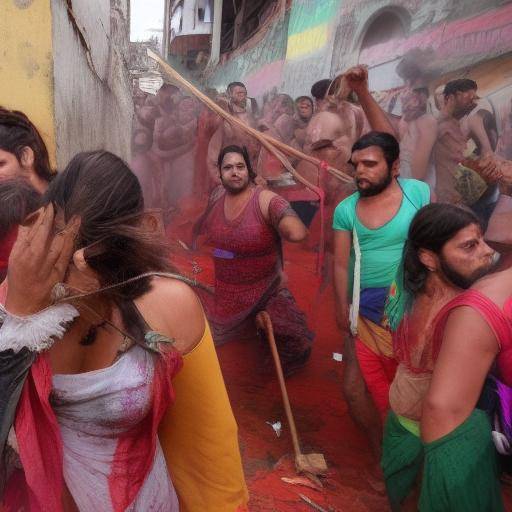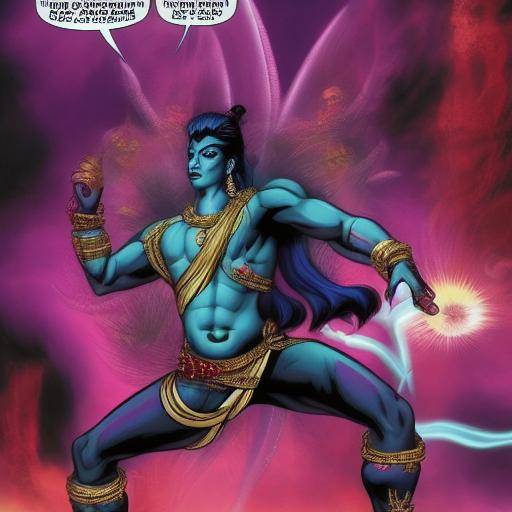
Kali is one of the most shocking and complex deities of the Hindu pantheon. His figure evokes power, transformation and duality. In this article, we will thoroughly explore the meaning and influence of Kali, the goddess of destruction and renewal. From its historical origins to its contemporary representations, we will discover how this mythological figure continues to inspire devotion and reflection today.
Introduction
The worship of Kali spans centuries of history and tradition. Its imposing presence and symbolism have fascinated people from diverse cultures and religions. In this article, we will deepen its origin, meaning and relevance in the Hindu religion, as well as in the contemporary interpretation of its figure. Join us on a journey to understand the fascinating essence of Kali, the goddess that brings with it both destruction and renewal.
Kali History and Background
The history of Kali dates back to the ancient traditions of Hinduism, where its presence is linked to the transformation of cosmic forces. It is recognized as the embodiment of primordial energy and as the goddess of death and destruction, but also of renewal and creation. His iconographies, artistic representations and religious texts reveal the complex amalgam of his attributes. From his first mentions in the Vedas to the proliferation of his devotees in contemporary India, Kali has remained unwavering in the Hindu worldview.
The worship of Kali has been manifested through various rituals, festivals and traditions that honor its transformative power. Hindu mythology is full of stories that illustrate its participation in cosmic and human events, which highlight its role as the destroyer of demons and protector of its followers. This constant flow between devastation and nutrition is one of the most enigmatic features of Kali, which places it at the centre of Hindu cosmovision and popular devotion.
Analysis in depth of the Kali Figure
Kali’s symbolism transcends mythological narratives and acquires broader meanings today. His image awakens reflections on human duality, spiritual transformation and personal renewal. From a modern perspective, Kali is interpreted as an archetype that challenges the apparent dichotomy between destruction and renewal, inviting introspection and inner growth.
Kali's contemporary representation in art, literature and popular culture has generated diverse and provocative interpretations. His iconic image, with multiple arms, a skull garland and a ferocious expression, has been both exalted and misunderstood in the modern world. Kali's impact on collective consciousness is a testimony to his persistent influence, which challenges conventional conceptions of divinity and transcends cultural barriers.
Comprehensive Review: Kali in the Current Society
Kali's presence in contemporary society is manifested through various artistic, philosophical and spiritual expressions. His image awakens debates about the nature of female power, the deconstruction of stereotypes and the interpretations of divinity in a diverse and complex world. As global consciousness incorporates a greater variety of religious and spiritual perspectives, the Kali figure remains a powerful symbol of resistance, transformation and empowerment.
Comparative Analysis: Kali and Other Deities
The comparison between Kali and other Hindu deities offers a wider view of their role in the divine pantheon. Although it shares certain attributes with other manifestations of female divinity, Kali's uniqueness lies in its dynamic representation of duality and its connection to the destructive and creative forces of the universe. As we enter this comparison, there are significant nuances that enrich our understanding of the Kali figure and its unique position within Hinduism.
Practical Tips and Recommendations
For those interested in further exploring Kali's meaning and influence, practical advice is provided that allows greater immersion in his veneration and symbolism. From participating in festivals dedicated to Kali to reading sacred texts related to his mythology, these recommendations foster a deeper appreciation of deity and his spiritual legacy.
Industry Perspectives and Expert Reviews
Professionals and researchers engaged in the study of Hinduism and religious traditions offer their perspective on the importance of Kali both in the religious sphere and in the broader context of culture and society. Its opinions provide a solid and based reflection on erudition, enriching the understanding of Kali's influence over the centuries and its relevance today.
Case Studies and Real Life Applications
Exploring specific cases in which Kali deity has had a significant impact allows us to appreciate its active presence in the daily lives of its devotees. These concrete experiences illustrate how the worship of Kali nourishes a deep connection between the divine and the human, generating tangible effects in the spiritual and emotional life of those who worship it.
Future Trends and Predictions
Finally, the emerging trends related to Kali's veneration are visible, projecting possible future scenarios in which his influence will continue to evolve. These predictions are based on current observations, sociocultural trends and academic projections, offering a look at the role that Kali could play in the coming religious and spiritual context.
Conclusions and FAQs
In short, the Kali figure emerges as a powerful symbol of transformation, feminine power and spiritual renewal. His presence transcends temporal and cultural boundaries, challenging entrenched conceptions and generating deep reflections on the nature of the human being and his relationship with the divine. Through this thorough journey, we have unraveled key aspects of Kali that invite continuous and enriching contemplation.
Frequently asked questions
What does Kali figure represent in Hinduism?
Kali is recognized as the goddess of destruction and renewal, symbolizing the transforming power of the divine in the Hindu worldview. His image awakens reflections on the duality and transition between opposing forces.
How is Kali worship celebrated?
The worship of Kali is manifested through festivals such as Kali Puja, in which rituals of worship are performed and their divine presence is honored. The devotees offer offerings and prayers to receive their protection and benevolent favors.
What is Kali's role in the daily lives of his devotees?
For Kali's devotees, his presence is a source of spiritual strength and comfort in times of crisis or uncertainty. Kali's veneration is used to find answers to personal and spiritual challenges.
What are the symbols associated with Kali?
Kali is represented with several symbolic attributes, such as a skull garland, a cut-head collar and a ferocious expression. These symbols reflect their connection to death, transformation and power.
What teachings or lessons are derived from Kali worship?
The worship of Kali addresses themes of spiritual transcendence, including acceptance of duality, overcoming fear and understanding of the cyclical nature of life. These teachings promote a transformative vision of the world and foster an attitude of courage in the face of the challenges of existence.
What is Kali's relevance in the modern era?
At present, Kali figure continues to inspire exploration of themes such as female empowerment, alternative spirituality and cultural diversity. His presence awakens an enriching dialogue on the nature of the sacred in an era of plurality and constant change.
In conclusion, Kali's iconoclastic figure transcends the limits of religion and stands as a timeless symbol of power, transformation and renewal. Its persistent influence on contemporary society reflects the ability of mythological deities to challenge and enrich the human understanding of the cosmos and spirituality. As we continue to explore the depths of mythology and devotion, Kali emerges as an inexhaustible source of reflection and astonishment, reminding us of the incomparable richness of the Hindu mythological legacy.
With this, we come to the end of our comprehensive analysis of the relevance and legacy of Kali, the goddess of destruction and renewal. If you have been intrigued by your figure or if you want to explore further the mysteries of this deity, we invite you to continue your inquiry into reliable sources and to deepen the spiritual wealth that Kali evokes.
In the hope that this article has provided an enriching approach to the presence of Kali in Hinduism and beyond, we thank you for accompanying us in this exploration. May the transforming force of Kali inspire your reflections and nourish your spiritual search.
Remember that, beyond destruction, the possibility of renewal and growth always emerges. In the Kali figure, we find an eternal reminder of the incessant dance of life and the transcendence of dualities.


